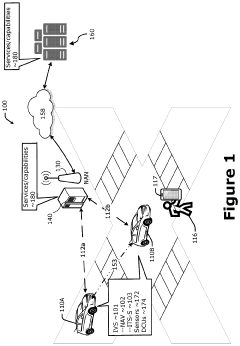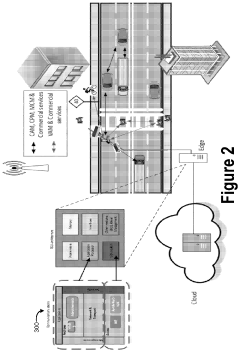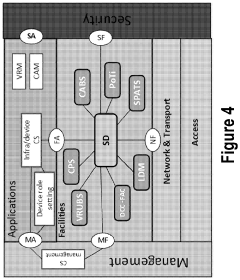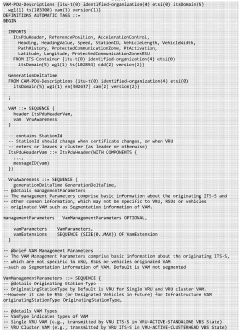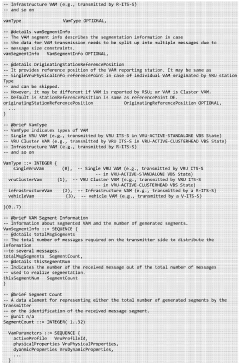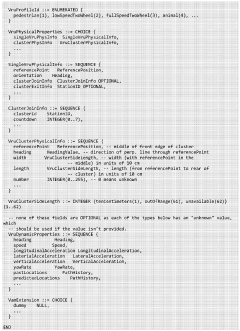How V8 Engines Facilitate Intelligent Transportation Systems?
JUL 4, 20259 MIN READ
Generate Your Research Report Instantly with AI Agent
Patsnap Eureka helps you evaluate technical feasibility & market potential.
V8 Engine Evolution in ITS
The evolution of V8 engines in Intelligent Transportation Systems (ITS) represents a significant technological advancement that has greatly enhanced the capabilities of modern vehicles. This progression can be traced through several key stages, each marked by notable improvements in performance, efficiency, and integration with smart technologies.
In the early stages of ITS development, V8 engines were primarily valued for their power output and reliability. These engines provided the necessary thrust for larger vehicles, which were increasingly being equipped with rudimentary intelligent systems. As ITS technologies began to emerge, engine management systems became more sophisticated, allowing for better control over fuel injection, ignition timing, and emissions.
The next phase saw the integration of electronic control units (ECUs) with V8 engines, enabling more precise management of engine parameters. This integration allowed for real-time adjustments based on driving conditions and vehicle data, marking a significant step towards intelligent engine operation. Concurrently, advancements in materials science and manufacturing techniques led to the development of lighter, more efficient V8 engines that could deliver improved performance while meeting stricter emissions standards.
As ITS technologies matured, V8 engines evolved to incorporate advanced sensors and communication systems. These enhancements enabled engines to interact with other vehicle systems and external infrastructure, facilitating features such as adaptive cruise control, lane-keeping assistance, and predictive maintenance. The ability of V8 engines to provide data on performance, fuel consumption, and emissions became crucial for fleet management and traffic optimization in ITS networks.
Recent developments have seen V8 engines becoming an integral part of hybrid powertrains in ITS applications. This evolution combines the power and reliability of V8 engines with electric motors, resulting in vehicles that can operate efficiently in various driving scenarios while still providing the performance expected from a V8. These hybrid systems leverage intelligent power management algorithms to optimize energy use and reduce emissions, aligning with the sustainability goals of modern ITS.
The latest iteration of V8 engines in ITS incorporates artificial intelligence and machine learning capabilities. These advanced engines can learn from driving patterns, predict maintenance needs, and adapt to changing environmental conditions. By analyzing vast amounts of data from various sources, including vehicle sensors, traffic information, and weather reports, these intelligent V8 engines can optimize their operation in real-time, contributing to safer, more efficient transportation systems.
Looking forward, the evolution of V8 engines in ITS is likely to continue, with a focus on further integration with autonomous driving technologies, enhanced connectivity, and improved environmental performance. As ITS networks become more sophisticated, V8 engines will play a crucial role in providing the power and intelligence needed to support increasingly complex transportation ecosystems.
In the early stages of ITS development, V8 engines were primarily valued for their power output and reliability. These engines provided the necessary thrust for larger vehicles, which were increasingly being equipped with rudimentary intelligent systems. As ITS technologies began to emerge, engine management systems became more sophisticated, allowing for better control over fuel injection, ignition timing, and emissions.
The next phase saw the integration of electronic control units (ECUs) with V8 engines, enabling more precise management of engine parameters. This integration allowed for real-time adjustments based on driving conditions and vehicle data, marking a significant step towards intelligent engine operation. Concurrently, advancements in materials science and manufacturing techniques led to the development of lighter, more efficient V8 engines that could deliver improved performance while meeting stricter emissions standards.
As ITS technologies matured, V8 engines evolved to incorporate advanced sensors and communication systems. These enhancements enabled engines to interact with other vehicle systems and external infrastructure, facilitating features such as adaptive cruise control, lane-keeping assistance, and predictive maintenance. The ability of V8 engines to provide data on performance, fuel consumption, and emissions became crucial for fleet management and traffic optimization in ITS networks.
Recent developments have seen V8 engines becoming an integral part of hybrid powertrains in ITS applications. This evolution combines the power and reliability of V8 engines with electric motors, resulting in vehicles that can operate efficiently in various driving scenarios while still providing the performance expected from a V8. These hybrid systems leverage intelligent power management algorithms to optimize energy use and reduce emissions, aligning with the sustainability goals of modern ITS.
The latest iteration of V8 engines in ITS incorporates artificial intelligence and machine learning capabilities. These advanced engines can learn from driving patterns, predict maintenance needs, and adapt to changing environmental conditions. By analyzing vast amounts of data from various sources, including vehicle sensors, traffic information, and weather reports, these intelligent V8 engines can optimize their operation in real-time, contributing to safer, more efficient transportation systems.
Looking forward, the evolution of V8 engines in ITS is likely to continue, with a focus on further integration with autonomous driving technologies, enhanced connectivity, and improved environmental performance. As ITS networks become more sophisticated, V8 engines will play a crucial role in providing the power and intelligence needed to support increasingly complex transportation ecosystems.
ITS Market Demand Analysis
The demand for Intelligent Transportation Systems (ITS) has been steadily growing, driven by the increasing need for efficient, safe, and sustainable transportation solutions. V8 engines, known for their power and performance, are playing a significant role in facilitating ITS by providing the necessary propulsion and energy management capabilities for various vehicles within the transportation ecosystem.
The global ITS market is experiencing robust growth, with projections indicating substantial expansion in the coming years. This growth is fueled by several factors, including urbanization, population growth, and the rising demand for smart mobility solutions. Governments worldwide are increasingly investing in ITS to address traffic congestion, improve road safety, and reduce environmental impact, creating a favorable market environment for V8 engine applications in ITS.
In the context of ITS, V8 engines are finding applications in various vehicle types, including commercial trucks, buses, and emergency response vehicles. These engines offer the power and torque required for heavy-duty applications while also providing the flexibility to integrate with advanced ITS technologies. The demand for V8 engines in ITS is particularly strong in regions with challenging terrains or extreme weather conditions, where their robust performance characteristics are highly valued.
One of the key drivers for V8 engine demand in ITS is the need for reliable and high-performance engines in public transportation systems. As cities expand their bus rapid transit (BRT) systems and other mass transit solutions, there is a growing requirement for engines that can deliver consistent performance under demanding conditions. V8 engines, with their ability to provide ample power and torque, are well-suited for these applications.
The emergency services sector is another area where V8 engines are in high demand within ITS. Police vehicles, fire trucks, and ambulances require powerful engines that can respond quickly to emergencies and navigate through traffic efficiently. V8 engines, integrated with ITS technologies such as traffic signal preemption systems, can significantly enhance the response times and overall effectiveness of emergency services.
In the commercial transportation sector, the demand for V8 engines in ITS applications is driven by the need for efficient and reliable long-haul trucking solutions. As logistics companies adopt advanced fleet management systems and real-time tracking technologies, V8 engines provide the necessary power and durability for extended operations while seamlessly integrating with these ITS components.
The market demand for V8 engines in ITS is also influenced by the ongoing development of connected and autonomous vehicle technologies. While there is a trend towards electrification in the automotive industry, V8 engines continue to play a crucial role in certain ITS applications where high power output and long-range capabilities are essential. This is particularly evident in hybrid vehicle systems, where V8 engines are combined with electric powertrains to offer both performance and improved fuel efficiency.
The global ITS market is experiencing robust growth, with projections indicating substantial expansion in the coming years. This growth is fueled by several factors, including urbanization, population growth, and the rising demand for smart mobility solutions. Governments worldwide are increasingly investing in ITS to address traffic congestion, improve road safety, and reduce environmental impact, creating a favorable market environment for V8 engine applications in ITS.
In the context of ITS, V8 engines are finding applications in various vehicle types, including commercial trucks, buses, and emergency response vehicles. These engines offer the power and torque required for heavy-duty applications while also providing the flexibility to integrate with advanced ITS technologies. The demand for V8 engines in ITS is particularly strong in regions with challenging terrains or extreme weather conditions, where their robust performance characteristics are highly valued.
One of the key drivers for V8 engine demand in ITS is the need for reliable and high-performance engines in public transportation systems. As cities expand their bus rapid transit (BRT) systems and other mass transit solutions, there is a growing requirement for engines that can deliver consistent performance under demanding conditions. V8 engines, with their ability to provide ample power and torque, are well-suited for these applications.
The emergency services sector is another area where V8 engines are in high demand within ITS. Police vehicles, fire trucks, and ambulances require powerful engines that can respond quickly to emergencies and navigate through traffic efficiently. V8 engines, integrated with ITS technologies such as traffic signal preemption systems, can significantly enhance the response times and overall effectiveness of emergency services.
In the commercial transportation sector, the demand for V8 engines in ITS applications is driven by the need for efficient and reliable long-haul trucking solutions. As logistics companies adopt advanced fleet management systems and real-time tracking technologies, V8 engines provide the necessary power and durability for extended operations while seamlessly integrating with these ITS components.
The market demand for V8 engines in ITS is also influenced by the ongoing development of connected and autonomous vehicle technologies. While there is a trend towards electrification in the automotive industry, V8 engines continue to play a crucial role in certain ITS applications where high power output and long-range capabilities are essential. This is particularly evident in hybrid vehicle systems, where V8 engines are combined with electric powertrains to offer both performance and improved fuel efficiency.
V8 Engine Challenges in ITS
The integration of V8 engines into Intelligent Transportation Systems (ITS) presents several significant challenges that require innovative solutions. One of the primary obstacles is the need for real-time data processing and decision-making capabilities. V8 engines, known for their high performance in traditional computing environments, must adapt to the dynamic and time-sensitive nature of ITS applications. This requires optimizing the engine's execution model to handle continuous streams of data from various sensors and devices while maintaining low latency responses.
Another challenge lies in the resource constraints of embedded systems commonly used in ITS. V8 engines, originally designed for desktop and server environments, must be optimized for memory-constrained devices without compromising performance. This necessitates careful memory management and garbage collection strategies to ensure efficient operation on limited hardware resources typically found in vehicles and roadside infrastructure.
Security and reliability are paramount in ITS, posing additional challenges for V8 engine implementation. The engine must incorporate robust security measures to protect against potential vulnerabilities and ensure the integrity of critical transportation data. Moreover, fault tolerance and error handling mechanisms need to be enhanced to maintain system stability in the face of unexpected inputs or hardware failures.
The diverse range of ITS applications, from traffic management to autonomous vehicle control, demands a high degree of flexibility from V8 engines. Adapting the engine to support various programming paradigms and domain-specific languages used in ITS development is crucial. This includes optimizing performance for both JavaScript and WebAssembly, as well as providing efficient interfaces for integration with existing ITS software stacks.
Energy efficiency is another significant concern, particularly for battery-powered devices in ITS networks. V8 engines must be optimized to minimize power consumption without sacrificing computational capabilities. This involves implementing intelligent power management techniques and exploring hardware-specific optimizations to maximize battery life in mobile ITS components.
Lastly, the challenge of scalability and distributed computing in ITS environments cannot be overlooked. V8 engines need to efficiently handle distributed workloads across multiple nodes in an ITS network, ensuring seamless communication and synchronization between various components. This requires developing robust networking protocols and load balancing mechanisms tailored to the unique requirements of intelligent transportation infrastructure.
Another challenge lies in the resource constraints of embedded systems commonly used in ITS. V8 engines, originally designed for desktop and server environments, must be optimized for memory-constrained devices without compromising performance. This necessitates careful memory management and garbage collection strategies to ensure efficient operation on limited hardware resources typically found in vehicles and roadside infrastructure.
Security and reliability are paramount in ITS, posing additional challenges for V8 engine implementation. The engine must incorporate robust security measures to protect against potential vulnerabilities and ensure the integrity of critical transportation data. Moreover, fault tolerance and error handling mechanisms need to be enhanced to maintain system stability in the face of unexpected inputs or hardware failures.
The diverse range of ITS applications, from traffic management to autonomous vehicle control, demands a high degree of flexibility from V8 engines. Adapting the engine to support various programming paradigms and domain-specific languages used in ITS development is crucial. This includes optimizing performance for both JavaScript and WebAssembly, as well as providing efficient interfaces for integration with existing ITS software stacks.
Energy efficiency is another significant concern, particularly for battery-powered devices in ITS networks. V8 engines must be optimized to minimize power consumption without sacrificing computational capabilities. This involves implementing intelligent power management techniques and exploring hardware-specific optimizations to maximize battery life in mobile ITS components.
Lastly, the challenge of scalability and distributed computing in ITS environments cannot be overlooked. V8 engines need to efficiently handle distributed workloads across multiple nodes in an ITS network, ensuring seamless communication and synchronization between various components. This requires developing robust networking protocols and load balancing mechanisms tailored to the unique requirements of intelligent transportation infrastructure.
Current V8 ITS Solutions
01 V8 Engine Design and Configuration
V8 engines are designed with eight cylinders arranged in two banks of four, forming a V-shape. This configuration allows for a compact design while providing high power output. The design often includes features for improved performance, fuel efficiency, and reduced emissions.- V8 Engine Design and Configuration: V8 engines are designed with eight cylinders arranged in two banks of four, forming a V-shape. This configuration allows for a compact design while providing high power output. Various aspects of V8 engine design, including cylinder arrangement, crankshaft configuration, and valve train systems, are continuously improved to enhance performance and efficiency.
- Fuel Injection and Combustion Optimization: Advancements in fuel injection systems and combustion chamber design for V8 engines focus on improving fuel efficiency and reducing emissions. This includes direct injection technology, variable valve timing, and optimized intake and exhaust systems to enhance combustion efficiency and power output.
- Turbocharging and Supercharging Systems: Forced induction systems, such as turbochargers and superchargers, are increasingly used in V8 engines to boost power output and improve efficiency. These systems compress the intake air, allowing for more fuel to be burned and resulting in increased power without significantly increasing engine size.
- Engine Management and Control Systems: Advanced electronic control units (ECUs) and engine management systems are developed to optimize V8 engine performance. These systems monitor and adjust various parameters such as fuel injection timing, ignition timing, and valve timing in real-time to maximize power output, fuel efficiency, and emissions control.
- Materials and Manufacturing Techniques: Innovative materials and manufacturing processes are employed in V8 engine production to reduce weight, improve durability, and enhance heat management. This includes the use of lightweight alloys, advanced coatings, and precision manufacturing techniques to produce more efficient and reliable V8 engines.
02 Valve Train and Cylinder Head Improvements
Advancements in V8 engine valve trains and cylinder heads focus on optimizing airflow, combustion efficiency, and overall engine performance. These improvements may include variable valve timing, multi-valve configurations, and innovative cylinder head designs.Expand Specific Solutions03 Fuel Injection and Combustion Optimization
Modern V8 engines incorporate advanced fuel injection systems and combustion chamber designs to enhance fuel efficiency and power output. This includes direct injection technology, improved fuel atomization, and optimized combustion chamber geometry.Expand Specific Solutions04 Engine Block and Crankshaft Innovations
Innovations in V8 engine blocks and crankshafts focus on reducing weight, improving strength, and enhancing overall engine durability. This may involve the use of advanced materials, optimized casting techniques, and innovative crankshaft designs for better balance and reduced vibration.Expand Specific Solutions05 Forced Induction and Power Enhancement
V8 engines often employ forced induction systems such as turbochargers or superchargers to increase power output. These systems, along with other power enhancement technologies, aim to boost performance while maintaining or improving fuel efficiency.Expand Specific Solutions
Key ITS V8 Engine Players
The V8 engine's role in Intelligent Transportation Systems (ITS) is evolving within a competitive landscape characterized by rapid technological advancements and growing market potential. The industry is in a transitional phase, moving from traditional combustion engines to more efficient and intelligent powertrain solutions. Major players like Huawei, GM, Intel, and Qualcomm are investing heavily in ITS technologies, focusing on integrating V8 engines with advanced electronics and connectivity features. The market size is expanding, driven by increasing demand for smart vehicles and infrastructure. While V8 engines are mature technology, their application in ITS is still developing, with companies like Hyundai and Volkswagen working on innovative solutions to enhance fuel efficiency and performance in connected vehicle ecosystems.
Huawei Technologies Co., Ltd.
Technical Solution: Huawei has developed a V2X (Vehicle-to-Everything) solution that leverages 5G technology to enhance Intelligent Transportation Systems (ITS). Their system utilizes V8 engines in conjunction with advanced sensors and AI algorithms to process real-time traffic data. The V8 engine's power and efficiency allow for rapid computation of complex traffic scenarios, enabling features such as predictive traffic management and adaptive signal control. Huawei's solution integrates with their 5G network infrastructure to provide low-latency communication between vehicles and roadside units, facilitating seamless data exchange for improved traffic flow and safety[1][3]. The system also incorporates edge computing capabilities, allowing for distributed processing of data closer to the source, reducing network congestion and improving response times in critical situations[2].
Strengths: Robust 5G integration, low-latency communication, and advanced edge computing capabilities. Weaknesses: Reliance on widespread 5G infrastructure deployment and potential security concerns with data handling.
GM Global Technology Operations LLC
Technical Solution: GM has developed an innovative ITS solution that leverages the power of V8 engines in conjunction with their OnStar connected vehicle platform. The system utilizes the V8 engine's performance capabilities to support advanced driver assistance features and autonomous driving technologies. GM's solution incorporates machine learning algorithms that analyze data from multiple sensors, including cameras, radar, and LiDAR, to create a comprehensive understanding of the vehicle's environment. The V8 engine's processing power enables real-time decision-making for adaptive cruise control, lane keeping, and collision avoidance systems. Additionally, GM has implemented vehicle-to-vehicle (V2V) communication protocols that allow their V8-equipped vehicles to share critical safety information, such as sudden braking or road hazards, with nearby vehicles[4][5]. This collaborative approach enhances overall traffic safety and efficiency.
Strengths: Established OnStar platform integration, advanced V2V communication capabilities, and extensive real-world testing. Weaknesses: Limited to GM vehicles, potentially reducing the overall impact on broader transportation systems.
V8 ITS Core Innovations
Intelligent transport system service dissemination
PatentPendingUS20230377460A1
Innovation
- The implementation of Upgradeable Vehicular Compute Systems (UVCS) and edge computing architectures for V2X services, enabling advanced sensing and communication protocols, such as the facilities layer-based service dissemination for commercial services and a layered costmap for real-time parking information sharing, which allows for efficient detection and communication of parking availability and supports VRU safety and traffic efficiency.
Generation and transmission of vulnerable road user awareness messages
PatentWO2021226059A1
Innovation
- The introduction of Vulnerable Road User Awareness Messages (VAMs) and infrastructure-assisted VRU clustering, where non-VRU ITS-Ss act as cluster heads, enabling the transmission of VRU awareness content for both equipped and non-equipped VRUs, and allowing for VAM segmentation to reduce communication overhead.
V8 ITS Fuel Efficiency
The integration of V8 engines with Intelligent Transportation Systems (ITS) has led to significant advancements in fuel efficiency for modern vehicles. V8 engines, known for their power and performance, have traditionally been associated with high fuel consumption. However, recent technological developments have enabled these engines to work in harmony with ITS to optimize fuel usage and reduce overall emissions.
One of the key ways V8 engines contribute to fuel efficiency in ITS is through advanced engine management systems. These systems utilize real-time data from various sensors and ITS components to adjust engine parameters dynamically. By continuously monitoring factors such as traffic conditions, road gradients, and vehicle speed, the engine management system can optimize fuel injection, ignition timing, and valve control to maximize efficiency.
Variable displacement technology, also known as cylinder deactivation, is another crucial feature in modern V8 engines that enhances fuel efficiency within ITS frameworks. This technology allows the engine to seamlessly switch between operating on all eight cylinders and running on four cylinders during low-load conditions. By deactivating unnecessary cylinders in light traffic or highway cruising scenarios, fuel consumption is significantly reduced without compromising performance when needed.
The integration of start-stop systems in V8 engines further contributes to fuel savings in urban environments. These systems automatically shut off the engine when the vehicle comes to a stop, such as at traffic lights or in congested areas, and restart it when the driver releases the brake pedal. This feature is particularly effective in reducing fuel waste during idle periods, which are common in city driving conditions.
Advanced thermal management systems in V8 engines also play a crucial role in improving fuel efficiency. By precisely controlling engine temperature and quickly bringing the engine to its optimal operating temperature, these systems reduce friction and improve overall engine efficiency. This is particularly beneficial in cold-start situations and short-distance trips, where traditional engines often operate less efficiently.
Furthermore, the incorporation of regenerative braking systems in vehicles equipped with V8 engines contributes to energy recovery and improved fuel economy. These systems capture kinetic energy during braking and deceleration, converting it into electrical energy that can be stored and used to power vehicle accessories or assist in acceleration, thereby reducing the load on the engine and conserving fuel.
In conclusion, the synergy between V8 engines and ITS has resulted in significant strides in fuel efficiency. Through advanced engine management, variable displacement technology, start-stop systems, thermal management, and energy recovery mechanisms, V8 engines are now able to deliver impressive performance while maintaining competitive fuel economy. This integration demonstrates the potential for traditional high-performance engines to adapt and thrive in the era of intelligent and sustainable transportation systems.
One of the key ways V8 engines contribute to fuel efficiency in ITS is through advanced engine management systems. These systems utilize real-time data from various sensors and ITS components to adjust engine parameters dynamically. By continuously monitoring factors such as traffic conditions, road gradients, and vehicle speed, the engine management system can optimize fuel injection, ignition timing, and valve control to maximize efficiency.
Variable displacement technology, also known as cylinder deactivation, is another crucial feature in modern V8 engines that enhances fuel efficiency within ITS frameworks. This technology allows the engine to seamlessly switch between operating on all eight cylinders and running on four cylinders during low-load conditions. By deactivating unnecessary cylinders in light traffic or highway cruising scenarios, fuel consumption is significantly reduced without compromising performance when needed.
The integration of start-stop systems in V8 engines further contributes to fuel savings in urban environments. These systems automatically shut off the engine when the vehicle comes to a stop, such as at traffic lights or in congested areas, and restart it when the driver releases the brake pedal. This feature is particularly effective in reducing fuel waste during idle periods, which are common in city driving conditions.
Advanced thermal management systems in V8 engines also play a crucial role in improving fuel efficiency. By precisely controlling engine temperature and quickly bringing the engine to its optimal operating temperature, these systems reduce friction and improve overall engine efficiency. This is particularly beneficial in cold-start situations and short-distance trips, where traditional engines often operate less efficiently.
Furthermore, the incorporation of regenerative braking systems in vehicles equipped with V8 engines contributes to energy recovery and improved fuel economy. These systems capture kinetic energy during braking and deceleration, converting it into electrical energy that can be stored and used to power vehicle accessories or assist in acceleration, thereby reducing the load on the engine and conserving fuel.
In conclusion, the synergy between V8 engines and ITS has resulted in significant strides in fuel efficiency. Through advanced engine management, variable displacement technology, start-stop systems, thermal management, and energy recovery mechanisms, V8 engines are now able to deliver impressive performance while maintaining competitive fuel economy. This integration demonstrates the potential for traditional high-performance engines to adapt and thrive in the era of intelligent and sustainable transportation systems.
V8 ITS Environmental Impact
The integration of V8 engines in Intelligent Transportation Systems (ITS) has significant environmental implications that warrant careful consideration. While these powerful engines offer enhanced performance capabilities, their impact on the environment is multifaceted and complex.
V8 engines, known for their high power output, have traditionally been associated with increased fuel consumption and higher emissions. However, in the context of ITS, their application can lead to both positive and negative environmental outcomes. On one hand, the superior acceleration and power of V8 engines can contribute to more efficient traffic flow in certain scenarios, potentially reducing overall congestion and, consequently, lowering emissions from idling vehicles.
Conversely, the inherent fuel inefficiency of V8 engines compared to smaller, more economical alternatives poses a challenge to environmental sustainability. The increased fuel consumption translates directly to higher carbon dioxide emissions, contributing to greenhouse gas accumulation and climate change. This aspect is particularly concerning in urban environments where air quality is already a pressing issue.
Advancements in engine technology have led to improvements in V8 efficiency, including the implementation of cylinder deactivation systems and start-stop technology. These innovations aim to reduce fuel consumption during low-load conditions, mitigating some of the environmental drawbacks. Additionally, the integration of V8 engines with hybrid powertrains in ITS applications offers a promising avenue for balancing performance requirements with environmental considerations.
The environmental impact of V8 engines in ITS extends beyond direct emissions. The manufacturing process of these larger, more complex engines typically requires more resources and energy compared to smaller engines, contributing to a higher carbon footprint throughout the product lifecycle. Furthermore, the increased weight of vehicles equipped with V8 engines can lead to greater wear on road infrastructure, necessitating more frequent repairs and maintenance, which in turn has its own environmental implications.
In the context of ITS, the use of V8 engines in emergency response vehicles and public transportation systems presents a unique environmental trade-off. While these applications may benefit from the enhanced performance characteristics of V8 engines, the environmental cost must be carefully weighed against the potential improvements in service efficiency and response times.
As ITS continues to evolve, the role of V8 engines and their environmental impact will likely be subject to ongoing scrutiny and regulation. Future developments in engine technology, alternative fuels, and ITS optimization algorithms will play crucial roles in determining the long-term viability and environmental sustainability of V8 engines within intelligent transportation ecosystems.
V8 engines, known for their high power output, have traditionally been associated with increased fuel consumption and higher emissions. However, in the context of ITS, their application can lead to both positive and negative environmental outcomes. On one hand, the superior acceleration and power of V8 engines can contribute to more efficient traffic flow in certain scenarios, potentially reducing overall congestion and, consequently, lowering emissions from idling vehicles.
Conversely, the inherent fuel inefficiency of V8 engines compared to smaller, more economical alternatives poses a challenge to environmental sustainability. The increased fuel consumption translates directly to higher carbon dioxide emissions, contributing to greenhouse gas accumulation and climate change. This aspect is particularly concerning in urban environments where air quality is already a pressing issue.
Advancements in engine technology have led to improvements in V8 efficiency, including the implementation of cylinder deactivation systems and start-stop technology. These innovations aim to reduce fuel consumption during low-load conditions, mitigating some of the environmental drawbacks. Additionally, the integration of V8 engines with hybrid powertrains in ITS applications offers a promising avenue for balancing performance requirements with environmental considerations.
The environmental impact of V8 engines in ITS extends beyond direct emissions. The manufacturing process of these larger, more complex engines typically requires more resources and energy compared to smaller engines, contributing to a higher carbon footprint throughout the product lifecycle. Furthermore, the increased weight of vehicles equipped with V8 engines can lead to greater wear on road infrastructure, necessitating more frequent repairs and maintenance, which in turn has its own environmental implications.
In the context of ITS, the use of V8 engines in emergency response vehicles and public transportation systems presents a unique environmental trade-off. While these applications may benefit from the enhanced performance characteristics of V8 engines, the environmental cost must be carefully weighed against the potential improvements in service efficiency and response times.
As ITS continues to evolve, the role of V8 engines and their environmental impact will likely be subject to ongoing scrutiny and regulation. Future developments in engine technology, alternative fuels, and ITS optimization algorithms will play crucial roles in determining the long-term viability and environmental sustainability of V8 engines within intelligent transportation ecosystems.
Unlock deeper insights with Patsnap Eureka Quick Research — get a full tech report to explore trends and direct your research. Try now!
Generate Your Research Report Instantly with AI Agent
Supercharge your innovation with Patsnap Eureka AI Agent Platform!
